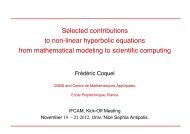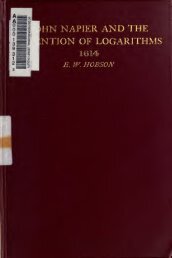The construction of the wonderful canon of logarithms
The construction of the wonderful canon of logarithms
The construction of the wonderful canon of logarithms
Create successful ePaper yourself
Turn your PDF publications into a flip-book with our unique Google optimized e-Paper software.
Construction <strong>of</strong> <strong>the</strong> Canon. 21<br />
T d <strong>the</strong> less limit <strong>of</strong> <strong>the</strong> logarithm which b c<br />
represents.<br />
29. <strong>The</strong>refore to find <strong>the</strong> limits <strong>of</strong><strong>the</strong> logarithm <strong>of</strong> a given<br />
sine.<br />
'<br />
By <strong>the</strong> preceding it is proved that <strong>the</strong> given<br />
_^<br />
sine being subtracted from radius <strong>the</strong> less limit<br />
remains, and that radius being multiplied into <strong>the</strong><br />
less limit and <strong>the</strong> product divided by <strong>the</strong> given<br />
sine, <strong>the</strong> greater limit is produced, as in <strong>the</strong> following<br />
example.<br />
30. Whence <strong>the</strong> first proportional <strong>of</strong> <strong>the</strong> First tab14, which is<br />
9999999, has its logarithm between <strong>the</strong> limits i.ooooooi<br />
and 1.0000000.<br />
For (by 29) subtract 9999999 from radius with<br />
cyphers added, <strong>the</strong>re will remain unity with its own<br />
cyphers for <strong>the</strong> less limit ; this unity with cyphers<br />
being multiplied into radius, divide by 9999999 and<br />
<strong>the</strong>re will result 1.0000001 for <strong>the</strong> greater limit, or<br />
3 1<br />
if you require greater accuracy 1.0000001 000000 1.<br />
• <strong>The</strong> limits <strong>the</strong>mselves differing insensibly, <strong>the</strong>y or anything<br />
between <strong>the</strong>m may be taken as <strong>the</strong> true logarithm.<br />
Thus in <strong>the</strong> above example, <strong>the</strong> logarithm <strong>of</strong><br />
<strong>the</strong> sine 9999999 was found to be ei<strong>the</strong>r i.0000000<br />
or i.ooooooio, or best <strong>of</strong> all 1.00000005. For<br />
since <strong>the</strong> limits <strong>the</strong>mselves, i.0000000 and<br />
I.OOOOOOI, differ from each o<strong>the</strong>r by an insensible<br />
fraction like iooooooo > <strong>the</strong>refore <strong>the</strong>y and whatever<br />
is between <strong>the</strong>m will differ still less from <strong>the</strong><br />
true logarithm lying between <strong>the</strong>se limits, and by<br />
a much more insensible error.<br />
3 2 . <strong>The</strong>re being any number <strong>of</strong> sines decreasingfrom radius<br />
in geometricalproportion, <strong>of</strong> one <strong>of</strong> which <strong>the</strong> logarithm or<br />
its limits is given, to find those <strong>of</strong> <strong>the</strong> o<strong>the</strong>rs.<br />
C 3 This


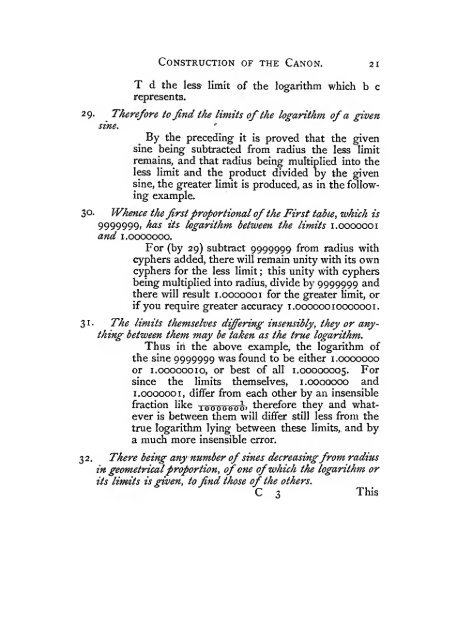
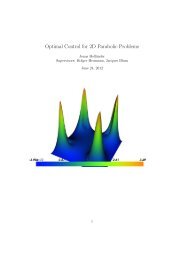
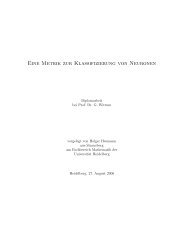
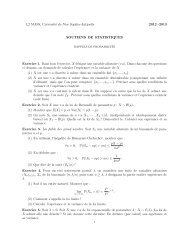
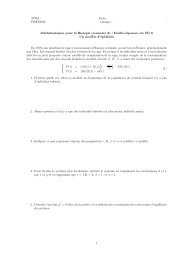


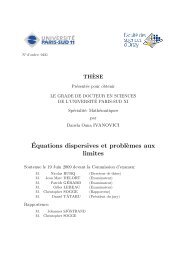
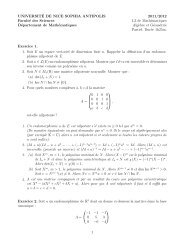
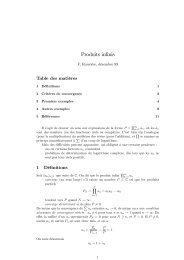
!['eries enti\`eres (+ [D78 Th d'Abel angulaire])](https://img.yumpu.com/14067031/1/184x260/eries-entieres-d78-th-dabel-angulaire.jpg?quality=85)
